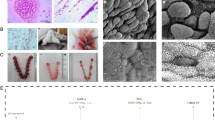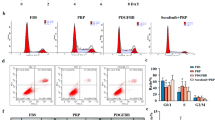Abstract
Purpose
Endometrial extracellular vesicles are essential in regulating trophoblasts’ function. This study aims to investigate whether endometrial extracellular vesicles (EVs) from recurrent implantation failure (RIF) patients inhibit the proliferation, invasion, and migration of HTR8/SVneo cells.
Methods
Eighteen RIF patients and thirteen fertile women were recruited for endometria collection. Endometrial cells isolated from the endometria were cultured and modulated by hormones, and the conditioned medium was used for EV isolation. EVs secreted by the endometrial cells of RIF patients (RIF-EVs) or fertile women (FER-EVs) were determined by Western blotting, nanoparticle tracking analysis, and transmission electron microscopy. Fluorescence-labeled EVs were used to visualize internalization by HTR8/SVneo cells. RIF-EVs and FER-EVs were co-cultured with HTR8/SVneo cells. Cell Counting Kit-8, transwell invasion, and wound closure assays were performed to determine cellular proliferation, invasion, and migration, respectively, in different treatments.
Results
RIF-EVs and FER-EVs were bilayer membrane vesicles, ranging from 100 to 150 nm in size, that expressed the classic EV markers Alix and CD9. RIF-EVs and FER-EVs were internalized by HTR8/SVneo cells within 2 h. The proliferation rate in the FER-EV group was significantly higher than that in the RIF-EV group at 20 μg/mL. Moreover, the invasion and migration capacity of trophoblast cells were decreased in the RIF-EV group relative to the FER-EV group at 20 μg/mL.
Conclusion
Endometrial EVs from RIF patients inhibited the functions of trophoblasts by decreasing their proliferation, migration, and invasive capacity. Such dysregulations induced by RIF-EVs may provide novel insights for better understanding the pathogenesis of implantation failure.



Similar content being viewed by others
Data availability
The data that support the findings of this study are available from the corresponding author upon reasonable request.
References
Martinez-Zamora MA, Tassies D, Reverter JC, Creus M, Casals G, Civico S, et al. Increased circulating cell-derived microparticle count is associated with recurrent implantation failure after IVF and embryo transfer. Reprod Biomed Online. 2016;33(2):168–73. https://doi.org/10.1016/j.rbmo.2016.05.005.
Koler M, Achache H, Tsafrir A, Smith Y, Revel A, Reich R. Disrupted gene pattern in patients with repeated in vitro fertilization (IVF) failure. Hum Reprod. 2009;24(10):2541–8. https://doi.org/10.1093/humrep/dep193.
Macklon N. Recurrent implantation failure is a pathology with a specific transcriptomic signature. Fertil Steril. 2017;108(1):9–14. https://doi.org/10.1016/j.fertnstert.2017.05.028.
Bashiri A, Halper KI, Orvieto R. Recurrent implantation failure-update overview on etiology, diagnosis, treatment and future directions. Reprod Biol Endocrinol. 2018;16(1):121. https://doi.org/10.1186/s12958-018-0414-2.
Vitagliano A, Saccardi C, Noventa M, Di Spiezio SA, Saccone G, Cicinelli E, et al. Effects of chronic endometritis therapy on in vitro fertilization outcome in women with repeated implantation failure: a systematic review and meta-analysis. Fertil Steril. 2018;110(1):103–12 e1. https://doi.org/10.1016/j.fertnstert.2018.03.017.
Coughlan C, Ledger W, Wang Q, Liu F, Demirol A, Gurgan T, et al. Recurrent implantation failure: definition and management. Reprod Biomed Online. 2014;28(1):14–38. https://doi.org/10.1016/j.rbmo.2013.08.011.
Achache H, Revel A. Endometrial receptivity markers, the journey to successful embryo implantation. Hum Reprod Update. 2006;12(6):731–46. https://doi.org/10.1093/humupd/dml004.
Bielfeld AP, Pour SJ, Poschmann G, Stuhler K, Krussel JS, Baston-Bust DM. A proteome approach reveals differences between fertile women and patients with repeated implantation failure on endometrial level-does hCG render the endometrium of RIF patients? Int J Mol Sci. 2019;20(2):425. https://doi.org/10.3390/ijms20020425.
Revel A, Achache H, Stevens J, Smith Y, Reich R. MicroRNAs are associated with human embryo implantation defects. Hum Reprod. 2011;26(10):2830–40. https://doi.org/10.1093/humrep/der255.
Nguyen HP, Simpson RJ, Salamonsen LA, Greening DW. Extracellular vesicles in the intrauterine environment: challenges and potential functions. Biol Reprod. 2016;95(5):109. https://doi.org/10.1095/biolreprod.116.143503.
Tkach M, Thery C. Communication by extracellular vesicles: where we are and where we need to go. Cell. 2016;164(6):1226–32. https://doi.org/10.1016/j.cell.2016.01.043.
Wiklander OPB, Brennan MA, Lotvall J, Breakefield XO, El Andaloussi S. Advances in therapeutic applications of extracellular vesicles. Sci Transl Med. 2019;11(492). https://doi.org/10.1126/scitranslmed.aav8521.
Ratajczak J, Wysoczynski M, Hayek F, Janowska-Wieczorek A, Ratajczak MZ. Membrane-derived microvesicles: important and underappreciated mediators of cell-to-cell communication. Leukemia. 2006;20(9):1487–95. https://doi.org/10.1038/sj.leu.2404296.
Burns G, Brooks K, Wildung M, Navakanitworakul R, Christenson LK, Spencer TE. Extracellular vesicles in luminal fluid of the ovine uterus. PLoS One. 2014;9(3):e90913. https://doi.org/10.1371/journal.pone.0090913.
Campoy I, Lanau L, Altadill T, Sequeiros T, Cabrera S, Cubo-Abert M, et al. Exosome-like vesicles in uterine aspirates: a comparison of ultracentrifugation-based isolation protocols. J Transl Med. 2016;14(1):180. https://doi.org/10.1186/s12967-016-0935-4.
Marinaro F, Macias-Garcia B, Sanchez-Margallo FM, Blazquez R, Alvarez V, Matilla E, et al. Extracellular vesicles derived from endometrial human mesenchymal stem cells enhance embryo yield and quality in an aged murine modeldagger. Biol Reprod. 2019;100(5):1180–92. https://doi.org/10.1093/biolre/ioy263.
Greening DW, Nguyen HP, Elgass K, Simpson RJ, Salamonsen LA. Human endometrial exosomes contain hormone-specific cargo modulating trophoblast adhesive capacity: insights into endometrial-embryo interactions. Biol Reprod. 2016;94(2):38. https://doi.org/10.1095/biolreprod.115.134890.
Properzi F, Logozzi M, Fais S. Exosomes: the future of biomarkers in medicine. Biomark Med. 2013;7(5):769–78. https://doi.org/10.2217/bmm.13.63.
Hannan NJ, Paiva P, Dimitriadis E, Salamonsen LA. Models for study of human embryo implantation: choice of cell lines? Biol Reprod. 2010;82(2):235–45. https://doi.org/10.1095/biolreprod.109.077800.
Yang Y, Chen X, Saravelos SH, Liu Y, Huang J, Zhang J, et al. HOXA-10 and E-cadherin expression in the endometrium of women with recurrent implantation failure and recurrent miscarriage. Fertil Steril. 2017;107(1):136–43 e2. https://doi.org/10.1016/j.fertnstert.2016.09.016.
Cutting R, Morroll D, Roberts SA, Pickering S, Rutherford A, Bfs, et al. Elective single embryo transfer: guidelines for practice British Fertility Society and Association of Clinical Embryologists. Hum Fertil (Camb). 2008;11(3):131–46. https://doi.org/10.1080/14647270802302629.
Stephenson EL, Braude PR, Mason C. International community consensus standard for reporting derivation of human embryonic stem cell lines. Regen Med. 2007;2(4):349–62. https://doi.org/10.2217/17460751.2.4.349.
Gardner DK, Schoolcraft WB. Culture and transfer of human blastocysts. Curr Opin Obstet Gynecol. 1999;11(3):307–11. https://doi.org/10.1097/00001703-199906000-00013.
Luckow Invitti A, Schor E, Martins Parreira R, Kopelman A, Kamergorodsky G, Goncalves GA, et al. Inflammatory cytokine profile of cocultivated primary cells from the endometrium of women with and without endometriosis. Mol Med Rep. 2018;18(2):1287–96. https://doi.org/10.3892/mmr.2018.9137.
Kong S, Zhou C, Bao H, Ni Z, Liu M, He B, et al. Epigenetic control of embryo-uterine crosstalk at peri-implantation. Cell Mol Life Sci. 2019;76(24):4813–28. https://doi.org/10.1007/s00018-019-03245-8.
Thery C, Amigorena S, Raposo G, Clayton A. Isolation and characterization of exosomes from cell culture supernatants and biological fluids. Curr Protoc Cell Biol. 2006;Chapter 3:Unit 3.22. https://doi.org/10.1002/0471143030.cb0322s30.
Guo F, Si C, Zhou M, Wang J, Zhang D, Leung PCK, et al. Decreased PECAM1-mediated TGF-beta1 expression in the mid-secretory endometrium in women with recurrent implantation failure. Hum Reprod. 2018;33(5):832–43. https://doi.org/10.1093/humrep/dey022.
Koot YE, van Hooff SR, Boomsma CM, van Leenen D, Groot Koerkamp MJ, Goddijn M, et al. An endometrial gene expression signature accurately predicts recurrent implantation failure after IVF. Sci Rep. 2016;6:19411. https://doi.org/10.1038/srep19411.
Bastu E, Demiral I, Gunel T, Ulgen E, Gumusoglu E, Hosseini MK, et al. Potential marker pathways in the endometrium that may cause recurrent implantation failure. Reprod Sci. 2019;26(7):879–90. https://doi.org/10.1177/1933719118792104.
Andronico F, Battaglia R, Ragusa M, Barbagallo D, Purrello M, Di Pietro C. Extracellular vesicles in human oogenesis and implantation. Int J Mol Sci. 2019;20(9):2162. https://doi.org/10.3390/ijms20092162.
Desrochers LM, Bordeleau F, Reinhart-King CA, Cerione RA, Antonyak MA. Microvesicles provide a mechanism for intercellular communication by embryonic stem cells during embryo implantation. Nat Commun. 2016;7:11958. https://doi.org/10.1038/ncomms11958.
Blazquez R, Sanchez-Margallo FM, Alvarez V, Matilla E, Hernandez N, Marinaro F, et al. Murine embryos exposed to human endometrial MSCs-derived extracellular vesicles exhibit higher VEGF/PDGF AA release, increased blastomere count and hatching rates. PLoS One. 2018;13(4):e0196080. https://doi.org/10.1371/journal.pone.0196080.
Baines KJ, Renaud SJ. Transcription factors that regulate trophoblast development and function. Prog Mol Biol Transl Sci. 2017;145:39–88. https://doi.org/10.1016/bs.pmbts.2016.12.003.
Burnett LA, Light MM, Mehrotra P, Nowak RA. Stimulation of GPR30 increases release of EMMPRIN-containing microvesicles in human uterine epithelial cells. J Clin Endocrinol Metab. 2012;97(12):4613–22. https://doi.org/10.1210/jc.2012-2098.
Latifi Z, Fattahi A, Ranjbaran A, Nejabati HR, Imakawa K. Potential roles of metalloproteinases of endometrium-derived exosomes in embryo-maternal crosstalk during implantation. Journal of Cellular Physiology. 2018;233(6):4530–45. https://doi.org/10.1002/jcp.26259.
Wortzel I, Dror S, Kenific CM, Lyden D. Exosome-mediated metastasis: communication from a distance. Dev Cell. 2019;49(3):347–60. https://doi.org/10.1016/j.devcel.2019.04.011.
Ferguson SW, Nguyen J. Exosomes as therapeutics: the implications of molecular composition and exosomal heterogeneity. J Control Release. 2016;228:179–90. https://doi.org/10.1016/j.jconrel.2016.02.037.
Tomasetti M, Lee W, Santarelli L, Neuzil J. Exosome-derived microRNAs in cancer metabolism: possible implications in cancer diagnostics and therapy. Exp Mol Med. 2017;49(1):e285. https://doi.org/10.1038/emm.2016.153.
Evans J, Rai A, Nguyen HPT, Poh QH, Elglass K, Simpson RJ, et al. In vitro human implantation model reveals a role for endometrial extracellular vesicles in embryo implantation: reprogramming the cellular and secreted proteome landscapes for bidirectional fetal-maternal communication. Proteomics. 2019:e1800423. https://doi.org/10.1002/pmic.201800423.
Kasvandik S, Saarma M, Kaart T, Rooda I, Velthut-Meikas A, Ehrenberg A, et al. Uterine fluid proteins for minimally invasive assessment of endometrial receptivity. J Clin Endocrinol Metab. 2020;105(1). https://doi.org/10.1210/clinem/dgz019.
Funding
The current study was supported by grants from the National Natural Science Foundation of China (NSFC 81771582 and NSFC 81701450).
Author information
Authors and Affiliations
Contributions
C.L. designed the experiments. C.L., L.L., H.Y., and S.S. collected the endometrial samples. C.L., S.S., and M.W. performed the experiments. C.L. wrote the manuscript, which was revised by H.Z. and C.S.
Corresponding author
Ethics declarations
Conflict of interest
The authors declare no competing interests.
Additional information
Publisher’s note
Springer Nature remains neutral with regard to jurisdictional claims in published maps and institutional affiliations.
Rights and permissions
About this article
Cite this article
Liu, C., Li, L., Wang, M. et al. Endometrial extracellular vesicles of recurrent implantation failure patients inhibit the proliferation, migration, and invasion of HTR8/SVneo cells. J Assist Reprod Genet 38, 825–833 (2021). https://doi.org/10.1007/s10815-021-02093-5
Received:
Accepted:
Published:
Issue Date:
DOI: https://doi.org/10.1007/s10815-021-02093-5




